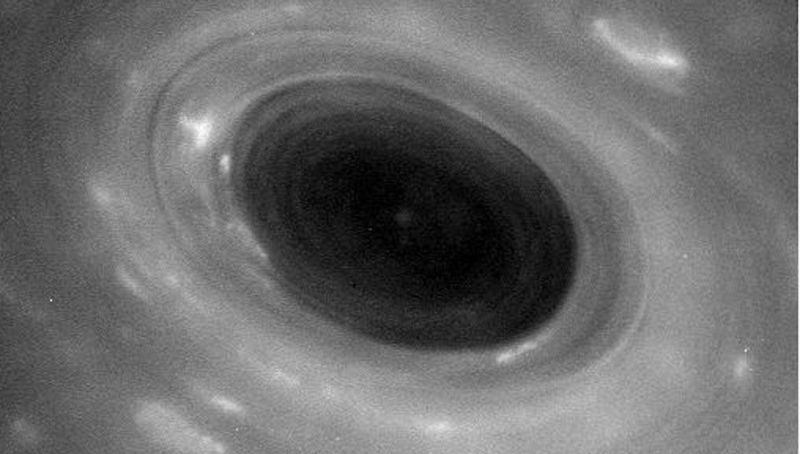It was 1:56PM Thursday afternoon AEST when a Deep Space Network receiver picked up a signal from NASA’s Cassini orbiter as it emerged from its first trip through the gap between Saturn and the gas giant’s rings. In the ensuing data came pictures of the planet’s north pole and cloud tops from only 3000km away — our closest look yet at the upper part of Saturn’s atmosphere, where the pressure is about the same as it is at sea level on Earth.
Image: NASA/JPL-Caltech/Space Science Institute
Researchers at the Jet Propulsion Laboratory were awestruck by the detail, but I was left with a question: What would it be like to actually visit the upper reaches of Saturn’s skies?
What initially caught my attention in the new images were the bright spots dotting the thin bands across the planet’s face. My assumption was that these were potential flickers of lightning captured by Cassini’s Imaging Science Subsystem Wide Angle Camera, but no. “We didn’t catch any lightning [on Thursday afternoon],” Caltech professor Andy Ingersoll, an expert in planetary atmospheres, told me when I called him to discuss the Saturnian weather I’d need to pack for.

Unprocessed image of Saturn’s atmosphere, taken on April 26. Image: NASA/JPL-Caltech/Space Science Institute
According to Ingersoll, the lighter blobs pictured above are clouds of ammonia floating about 150km atop the next closest layer of the atmosphere. If you were suspended in a hydrogen balloon (not helium, as a helium balloon in a hydrogen atmosphere would “sink like a rock,” Ingersoll said), these ammonia clouds would look very similar to our water vapour cumulus clouds here on Earth.
“There probably are clouds of water vapour down deeper but we can’t see them as well because it’s frozen. The water [freezes] at greater depth than the ammonia,” said Ingersoll. “So, we typically see ammonia clouds and that’s what I think these are, as warm air rises up and condenses out cloud particles.” Warm, it should be noted, is a relative term — temperatures average -270C in Saturn’s upper atmosphere, so bring a coat.
Animation of images from @CassiniSaturn‘s close pass over #Saturn on April 26 pic.twitter.com/yklpSXJwrS
— Jason Major (@JPMajor) April 27, 2017
On Wednesday night, Cassini captured a series of photos that began with the spinning gyre in the centre of Saturn’s north pole hexagon. Travelling southward, it eventually flew by the equator at a brisk 124,000km/h. If the camera was shooting in colour, we would have seen the cerulean blue of the north pole’s inner vortex, but the spacecraft’s speed required monochrome photography.
“Unfortunately, we’re seeing [these features] only in black and white,” said Ingersoll. “That was just inevitable because we were flying so fast we couldn’t afford to put a filter on the camera because it would have smeared the images too much. We needed to collect all the light there was.”
What was astonishing to Ingersoll was how clear the streaky clouds of ammonium hydrosulphide were beneath those fluffy ammonia clouds — and their scale. “There were these long threads of clouds, filamentary clouds pretty unlike Earth clouds,” he said. “It’s as if you had you pulled the atmosphere out and the clouds refused to mix with each other.”
That could have something to do with another phenomenon Ingersoll observed: The stringy clouds were very orderly, as if nothing was disturbing the air, despite the fact that winds on Saturn reach up to 1800km/h. That could speak to a fundamental aspect of the outer planets’ atmospheres.

Image: NASA/JPL-Caltech/Space Science Institute
“[Thursday’s photo data] bears on the question of why are the winds actually stronger on Saturn than they are Jupiter, and why are both of them stronger than the winds on Earth,” Ingersoll said. “And I think it’s because there’s just less turbulence the farther out you go in the solar system.”
Wednesday night’s close brush with Saturn was just the first of the 22 passes scheduled before Cassini’s final descent this September, but it’s only one of three or four where visual light data will be collected. What Ingersoll is looking forward to in future flybys are readings that pierce through the upper cloud layer and into the depths of the planet. Magnetic, infrared and microwave sensors will be pointed at Saturn on future flybys, cutting through the opaque cloud cover and into the gas giant’s core to get our best view yet of the structure of the planet.
View from @CassiniSaturn approaching Saturn’s north pole early yesterday morning, preparing for the first fateful ring dive #CassiniInspires pic.twitter.com/PySHdNQMyq
— Conor A Nixon (@Shamrocketeer) April 28, 2017
“[Cassini’s] camera is only one of its instruments,” he said. “In fact, Cassini is a very wonderful spacecraft because of the variety of instruments that it has.”
Ingersoll mentioned the final Grand Finale observation he was looking forward to most at the very end of our conversation, which could solve an ongoing mystery of the planet’s formation. Saturn’s magnetic field has a very unusual property in that it’s “axisymmetric” — it has no tilt. That’s weird, because the maths behind planetary magnetic fields requires a bit of tilt.
“How does a planet generate a magnetic field? The off-axis tilt is sort of part of that whole theory and if there’s no tilt at all, well, it will be interesting,” he said with a chuckle.
